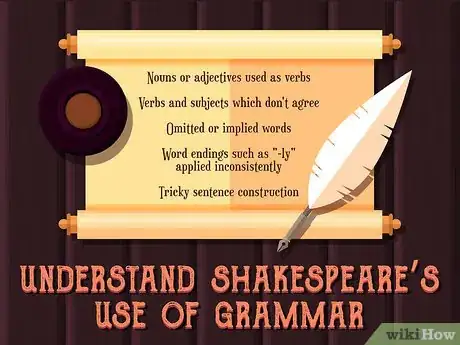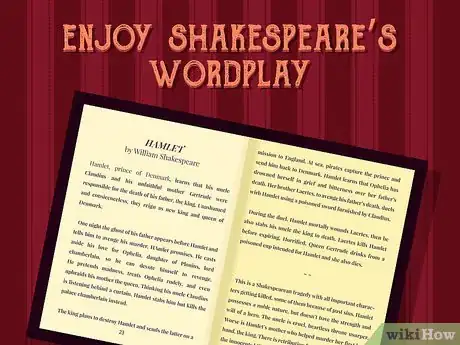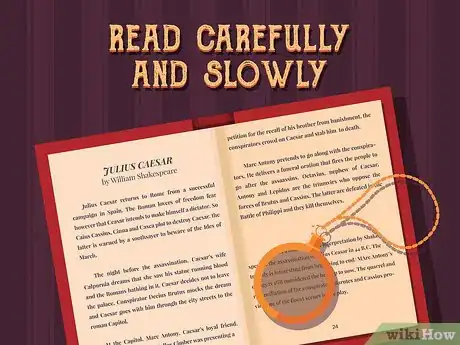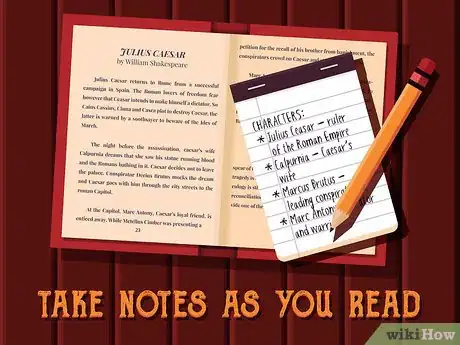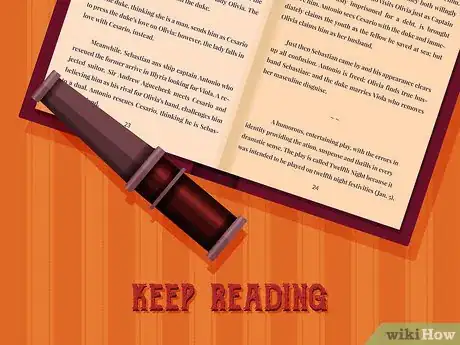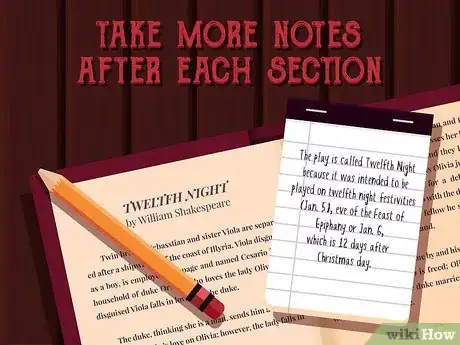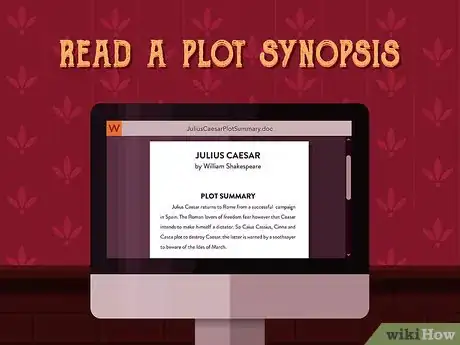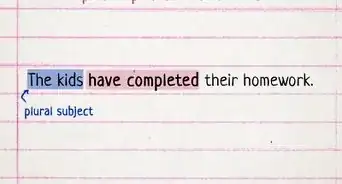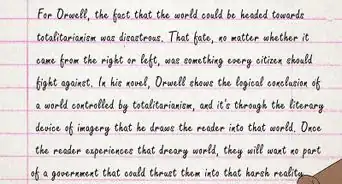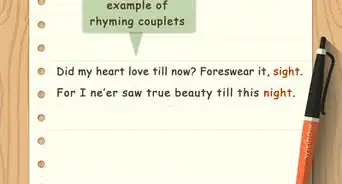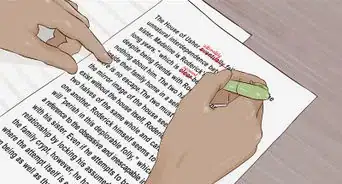This article was co-authored by Michelle Golden, PhD. Michelle Golden is an English teacher in Athens, Georgia. She received her MA in Language Arts Teacher Education in 2008 and received her PhD in English from Georgia State University in 2015.
wikiHow marks an article as reader-approved once it receives enough positive feedback. In this case, 87% of readers who voted found the article helpful, earning it our reader-approved status.
This article has been viewed 247,770 times.
Reading Shakespeare's works will be fun, but it can be a confusing and frustrating experience for the beginner, partially because of Shakespeare’s style and the difference in language between now and Tudor England in which Shakespeare lived. But with a few steps and some preparation, you'll be well-equipped and ready to enjoy reading a play in no time!
Steps
Selecting Your Text and Preparing Yourself
-
1Select a play. If you are able to choose your own play, pick something easy and something you might already be familiar with to start. Most editions will have a brief synopsis printed on the back cover. If the play sounds intriguing, it might make for a good selection.
- Romeo and Juliet is often a good starting point because many of us are familiar with the “star-crossed lovers” plot.
- Consider a comedy, like Taming of the Shrew, a play which has been adapted to film for modern audiences.
- Macbeth is another popular Shakespearean tragedy, and if you are interested in political intrigue, this might be the play for you.
-
2Choose a good edition. There are two major choices to make. The first choice is between texts that have been modernized to smooth over the differences in language use from Shakespeare’s time to our own time, or texts that have not been modernized. The second choice is between texts that are annotated or non-annotated. Annotated texts may provide definitions, context, and value-added information that will help you to form a deeper understanding of what is going on in the play.
- The "No Fear Shakespeare" series is a good option that offers the original text side-by-side with modernized text. Remember that modernized text should support understanding, and not replace the original.
- Popular annotated versions are available by Arden and Oxford. Non-annotated texts will provide just the text as it was originally written.
Advertisement -
3Familiarize yourself with the most frequent “Shakespearisms.” Language is always evolving, and some of the words in Shakespeare's plays have a different meaning today than when the plays were written, or they are no longer in use. When in doubt, use the context of the sentence to figure out the meaning or reference an online Shakespearean glossary. Here are some examples:
- ”Thee” as “you.” For example: “When will I see thee next?”
- ”Thou” as “you.” For example: “Thou art a villain.”
- ”Thy as “your.” For example: “Thy name is more hateful than thy face.”
- ”Hath” as “has.” For example: “He hath killed many a man.” OR “He hath a horse.
-
4Understand Shakespeare’s use of grammar. In Shakespeare’s writing, parts of speech are frequently switched and "normal" sentence order is often varied, often for the sake of rhyme or meter (which is like rhythm). Shakespeare often played with standard language; some common features include:
- Nouns or adjectives used as verbs
- Verbs and subjects which don't agree
- Omitted or implied words
- Word endings such as "-ly" applied inconsistently
- Tricky sentence construction.
- For instance, where we say "John caught the ball," Shakespeare might write "John the ball caught," or even "The ball John caught."[1]
-
5Enjoy Shakespeare’s wordplay. In Shakespeare’s writing, metaphors and similes may make some passages more difficult to understand. Shakespeare also heavily used puns, double meanings, and malapropisms for comedic effect.
- An example of a Shakespearean metaphor compares life to the theatre stage: "All the world's a stage, and all the men and women merely players. They have their exits and their entrances; and one man in his time plays many parts."
- An example of a Shakespearean pun: after Hamlet has killed Polonius and hidden his body, the king asks him where Polonius is. Hamlet tells him he is at supper – “not where he eats, but where he is eaten,” meaning that Polonius is the supper – for worms.
- An example of a Shakespearean malapropism: officer Dogberry said, "Our watch, sir, have indeed comprehended two auspicious persons" (apprehended two suspicious persons).[2] [3]
-
6Gather other resources you might need. Gather reference resources that you can refer to if you have a question about something you have just read. Here are a few examples of potential resources.
- A dictionary
- A tablet to easily access internet reference material
- Links to websites that will help you understand the language. For example: Early English Grammar Sheets (http://homepages.wmich.edu/~cooneys/tchg/lit/adv/shak.gram.html), Shakespeare’s Language (http://www.bardweb.net/language.html), and Pronunciation (http://www.renfaire.com/Language/pronunciation.html).[4]
Reading the Text
-
1Read carefully and slowly. Before you start, set aside some time in a quiet area. Move through the text slowly, and don’t be afraid to use your dictionary or reference materials if you are lost or confused.
-
2Take notes as you read. You can make your notes on a separate sheet of paper, where you can write general thoughts, questions, or important ideas or plot points. If you own the text, you might want to consider highlighting key phrases or writing notes in pencil in the book. Also, consider the following questions.
- What are the important main events?
- Which characters are involved in the sub-plot and how does the sub-plot relate to the chief plot?
- What is the relationship of characters to each other?
- What motivates the characters?
- What is the central point or lesson of the play?[5]
-
3Reread the text. Do not be discouraged if you must re-read passages several times. Even literary scholars often return to key lines. Each time you read a passage you will gain a deeper understanding of what is going on in the play.[6]
-
4Keep reading. Remember that reading the play you’ve chosen should be fun. Push on through and keep reading. Don’t let outdated language or references stop you from enjoying the play.
-
5Take more notes after each section. When you are finished with a section, take out a fresh sheet of paper and take some more notes.
- Write a summary of each scene or act.
- Record questions or thoughts you may have about the scene.
- Record any new words, phrases, and their definitions that you looked up during reading. [7]
Going Above and Beyond
-
1Discuss the text with friends. Discuss the text or an individual scene with your friends. If you are reading on your own, make use of internet discussion boards for feedback. Feel free to ask your friends or people on the discussion board the questions that you wrote down in your notes.
-
2Perform or speak the play. Shakespeare's plays were written as dramatic literature and were meant to be performed and heard aloud. As a result, reading the play outloud or performing scenes with friends might give you insight that you would have otherwise missed during a quiet reading.[8]
-
3Watch a play, a movie, or listen to audio recordings of Shakespeare’s work. Do this after you’ve read the play on your own. If you have finished reading one of Shakespeare's more popular plays, there is a very good chance it has been produced into a film. There are also a wide variety of Shakespeare’s plays on audiobook that you can download to your iPod or another device. But remember, modern plays or film adaptations might give different meaning or be shown in a different context than the original play. Think about the below questions when you watch the play or film.
- How does the performance compare with your perceptions of the play?
- Was there something the actor provided that you did not consider?
- Was there something you would have done differently?[9]
-
4Read a plot synopsis. After you are done reading, find a plot summary or synopsis. Try to find a synopsis that incorporates passages from the play directly into the discussion. These summaries and synopsis will help correct any misunderstanding that you might have after reading the play. Alternately, you can read the synopsis before you’ve read the text. [10]
Community Q&A
-
QuestionWhat are the age ranges of Shakespeare books?
 Kathryn LemonCommunity AnswerThere aren't any specific age ranges, but because they require some comprehension to understand, they are more ideal for older readers. However, there are books out there written for children about Shakespeare and his works if you want to introduce a child early on.
Kathryn LemonCommunity AnswerThere aren't any specific age ranges, but because they require some comprehension to understand, they are more ideal for older readers. However, there are books out there written for children about Shakespeare and his works if you want to introduce a child early on.
References
- ↑ http://www.bardweb.net/content/ac/shakesreader.html
- ↑ http://examples.yourdictionary.com/examples-of-malapropism.html#vvlzAhKxqWgw2McE.99
- ↑ http://www.bardweb.net/content/ac/shakesreader.html
- ↑ https://shakeyoursphere.wordpress.com/2009/03/25/ways-to-meet-shakespeare-a-beginners-list-of-dos-and-donts/
- ↑ http://www.shakespeare-online.com/plays/howtostudybard.html
- ↑ http://www.shakespeare-online.com/plays/howtostudybard.html
- ↑ http://www.shakespearehigh.com/classroom/guide/page4.shtml
- ↑ http://www.bardweb.net/content/ac/shakesreader.html
- ↑ http://www.shakespeare-online.com/plays/howtostudybard.html
About This Article
Even if you’re a beginner, you can start reading Shakespeare by choosing a familiar text and preparing yourself properly. Start by choosing a play that seems interesting to you and that you might be familiar with. For example, if you’ve heard of Romeo and Juliet or Macbeth, reading these is a great place to start. Before you start reading, spend some time familiarizing yourself with Shakespeare’s use of grammar, such as the switched sentence order, the rhyming structure, and the meter or the rhythm of his sentences. You can also study common “Shakespearnisms” such as using “thee” as “you” or “hath” as “has” so you can more easily read through the text. For tips about how to perform or speak the text out loud, keep reading!



